
International Research Journal of Engineering and Technology (IRJET) e-ISSN: 2395-0056 p-ISSN: 2395-0072
Volume: 11 Issue: 04 | Apr 2024 www.irjet.net


International Research Journal of Engineering and Technology (IRJET) e-ISSN: 2395-0056 p-ISSN: 2395-0072
Volume: 11 Issue: 04 | Apr 2024 www.irjet.net
Prathamesh L. Khandelwal1 , Prof. Pallavi H. Dhole2 , Khushi R. Kawanpure3 , Pranoti P. Pohokar4 , Puja R. Jadhav5,Tanay A. Nanglia6
1Student, Sipna College of Engineering and Technology, Maharashtra, India
2Assistant Professor, Sipna College of Engineering and Technology, Maharashtra, India
3Student, Sipna College of Engineering and Technology, Maharashtra, India
4Student, Sipna College of Engineering and Technology, Maharashtra, India
5Student, Sipna College of Engineering and Technology, Maharashtra, India
6Student, Sipna College of Engineering and Technology, Maharashtra, India
Abstract - The study presents a comprehensive exploration of cryptographic techniques, tracing their evolutionfromancienthistoricalperiodstocontemporary technological advancements. Motivated by the need for a versatile platform encompassing both symmetric and asymmetricencryptionalgorithms,ourresearchintroduces astandaloneapplicationdesignedtoserveasaunifiedhub forcryptographicoperations.Thisplatformintegratesmajor encryptionmodes,includingCaesarCipher,AESAlgorithm, ModifiedCaesarCipher,andRSA,alongsidetwoproprietary algorithms,namelytheArithmeticNoKeyAlgorithmandBit ManipulationAlgorithm.Leveragingmodulardevelopment principlesandtheJavaCryptographicExtensionFramework, the application exhibits enhanced flexibility and usability, cateringtousersrangingfromcryptographyenthusiaststo professionals. By using Dynamic Loading, the application seamlessly ties together diverse cryptographic tools, promoting worldwide awareness of cryptography and its applications. Through a holistic approach, our research endeavors to bridge classic and modern cryptographic methods, thereby fostering a deeper understanding and appreciationoftheintricaciesofencryptionanddecryption techniquesintoday'sdigitallandscape.
Key Words: [Symmetric Key Cryptography, Modified Caesar Cipher, AES, RSA, Arithmetic No Key, Bit ManipulationFixedKey]
As Technique of Encryption and decryption is not very hard to understand because we already usingdifferent encryptionmethodstotransferourmessagesince from Ancient historical Period to today’s technologicalera.Hereweareprovidingplatformfor
both the symmetric as well as Asymmetric key cryptographicalgorithms specificallykeepingitseye onall-in-oneencryptionstandardsviaincorporating major four encryption modes Caesar Cipher, AES Algorithm,ModifiedCaesarcipher,RSA.SixAlgorithms we have inserted here out of which two are indigenously made named as Arithmetic No Key AlgorithmandBitManipulationAlgorithm.Motivation for building this project comes from software Engineering Project where we come up with lots of ideasandfinally,wefinalizethistopic.
Astherearelots ofcryptographictoolsand website are available in the world of Cryptography but we are tryingtomakeonesuchmechanismwherewecantie both the symmetric and asymmetric key algorithms witheachotherbyusingDynamicLoading.ItisaStandAlone Application which can perform multiple Encryption via using Java (JDK 21 and above). This Stand-Alone Application system that aims enhancing worldwide awareness of cryptography and its uses; JAVACryptographicextensionFrameworkisthebaseof theseproposedsystemmechanism.Inthisapplication we have used modular development hence flexibility of applicationisincreased.Combinedeffortshaveledto the development of a Stand-alone application that shows several classic and modern methods of cryptography, amongst which: Caesar ciphers and variousmethodsofcryptanalysis.
“THE HANDBOOK ON APPLIED CRYPTOGRAPHY” has given a brief account on cryptographictoolworkinganduses[1].

International Research Journal of Engineering and Technology (IRJET) e-ISSN: 2395-0056 p-ISSN: 2395-0072
Volume: 11 Issue: 04 | Apr 2024 www.irjet.net
BhumanVyasin"SecurityChallengesandSolutions in Java Application Development" addresses the security landscape specific to Java applications. Vyas explores vulnerabilities and offers solutions tailoredtoJavaenvironments,likelyencompassing topics such as secure coding practices, access control,andencryptiontechniques[2].
Zhengyi Lu conducts an in-depth analysis of the AdvancedEncryptionStandard(AES)in"Analysis on AES encryption standard and safety". This analysis, presented at the Third International Symposium on Computer Engineering and IntelligentCommunications,providesinsightsinto the safety and efficacy of AES, a fundamental encryption standard used in Java application security[3].
Yashar Salami, Vahid Khajehvand, and Esmaeil Zeinali'sworktitled"CryptographicAlgorithms:A Review of the Literature, Weaknesses and Open Challenges" offers a comprehensive review of cryptographic algorithms. Their paper, likely covering both symmetric and asymmetric cryptography, highlights weaknesses and challenges, providing valuable insights for implementing secure cryptographic solutions in Javaapplications[4].
ArwaZabian,ShakirMrayyen,AbramMagdyJonan, Tareq Al-Shaikh, and Mohammed Tthazi Al-Khaiyat propose a "Multi-layer encryption algorithm for data integrity in cloud computing". Although not directly focused on Java, this paper introduces encryptiontechniquesrelevanttosecuringdatain distributed environments, which are often encounteredinJavabasedcloudapplications[5].
M A. Al-Shabi's "A Survey on Symmetric and Asymmetric Cryptography Algorithms in Information Security" provides a survey of cryptographic algorithms. This survey, likely encompassingvariousencryptiontechniques,offers insightsintotheirapplicabilityandeffectivenessin information security, pertinent for securing Java applications[6].
Prof. (Dr.) Amit Verma and Anjali Gakhar analyze "ToolsandTechniquesinCryptography",shedding light on available cryptographic tools and methodologies.WhilenotJava-specific,thisanalysis offers valuable insights into integrating cryptographic techniques into Java application securityframeworks[7].
Punita Meelu and Sitender Malik explore "AES: A Symmetric Key Cryptographic System". Although an olderpublication,thispaperremainsrelevantasit provides a detailed examination of AES, a cornerstone encryption algorithm utilized in Java applicationsecurityforsecuringsensitivedata[8].
Tanusree Saha's "Complement-Based Modified ApproachtoSecureSmallTextMessageCombining Triangulation Method” proposes an enhanced Symmetric key encryption algorithm which is the combination of substitution technique, 2’s compliment technique and Triangulation Method[9].
Deepak & Parveen work “Modern Encryption and DecryptionAlgorithmbasedonASCIIValue,Integer array,BytearrayandBinaryOperations”proposed an algorithm based on ASCII values and binary operations for both encryption and decryption to enhancethesecurity[10].
Shashi Gautam, Shubha Mishra, & Dr. Manish Shrivastava work titled “An Enhanced Encryption Technique using BCD and Bit Complementation”. They proposed a cryptographic algorithm based on binary operations and with basic CPU computation. ThisalgorithmusesBCD(binarycodeddecimal),1's complement for data encryption and 2's complementforkeyencryption[11].
1. Multiple Encryption Algorithm
2. Flexibility in accessing file
3. Stand Alone Application.
4. Text based and File based Input and output both the options are available for the user.
5. Optimized memory utilization.
6. Modular Software Designing approach is used.
7. Iterative development approach used

International Research
of
and Technology (IRJET) e-ISSN: 2395-0056 p-ISSN: 2395-0072 Volume: 11 Issue: 04 | Apr 2024 www.irjet.net
This mechanism provides both the symmetric and asymmetrickeyCryptographicAlgorithms.
1) To place both these algorithms at one we have proposed here common Interface called Crypto AlgorithmInterfaceandboththesymmetricand asymmetric algorithms have to compulsorily implement.
2) The interface CryptoAlgorithm consists of two methods-encrypt()anddecrypt().Bothofthese methods have a return type and parameter of String to ensure that they accept and return Strings.
3) The AlgorithmLoader is a module designed to dynamically load and manage cryptographic algorithmsusedintheapplication.Itspurposeis to provide a flexible way to integrate different encryption and decryption algorithms without tightly coupling them to the main application logic.
4) By creating the AlgorithmLoader, we avoid hardcoding specific cryptographic algorithms directlyintotheapplicationcode.Thisdynamic loading process at runtime enables our application to support multiple algorithms without altering the core code. This not only saves time and effort but also enhances the flexibilityandscalabilityoftheSystem.
5) Initialization:TheAlgorithmLoaderisinitialized whentheapplicationstarts.
6) Scanning for Algorithm Classes: It scans the specified package (in our implementation "cryptoAlgos") for classes that implement the CryptoAlgorithm interface. Loading Algorithm Classes:Itloadsthealgorithmclassesdynamically using Java reflection. The classes are identified, andJavareflectionisusedtoloadthemintothe application dynamically. This is done using the Class.forName() method, which takes the fully qualified classnameasa stringandreturnsthe Classobjectforthatclass.
7) StoringAlgorithmClasses:Theloadedalgorithm classes are stored in a list or data structure for easyaccess.
8) Algorithm Selection: When needed, the applicationcanrequestaspecificalgorithmbyits namefromtheAlgorithmLoader.
9) Instantiation: After loading the names into the System, the user is asked to select a specific Algorithmmoduleclass,andthentheReflectionis used again to instantiate the objects of the selected class. This is typically done using the Class.newInstance() method or by calling a constructorusingConstructor.newInstance().
10) Returning Algorithm Object: It returns the instantiated algorithm object to the application forencryptionordecryption.
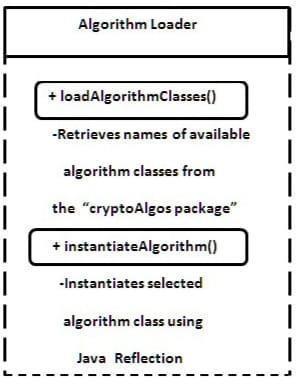
Figure: - 01(Working of Algorithm Loader)
Proposed Application specially includes total 6 algorithmsoutofwhich4arestudiedbyusand2of themarecreatedbyusproprietaryalgorithms.
Key terms
1) KEY =Akeyincryptographyisapieceof information,usuallyastringofnumbersorletters that are stored in a file, which, when processed

International Research Journal of Engineering and Technology (IRJET) e-ISSN: 2395-0056 p-ISSN: 2395-0072
Volume: 11 Issue: 04 | Apr 2024 www.irjet.net
throughacryptographicalgorithm,canencodeor decodecryptographicdata.
2) Encryption =Encryption is a way of scramblingdatasothatonlyauthorizedpartiescan understandthe information.
3) Decryption=The process of encryption transforms information from its original format called plaintext into an unreadable format called ciphertext whileitisbeingsharedortransmitted.
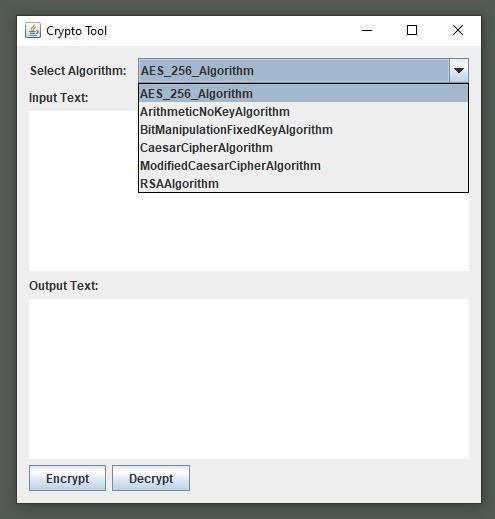
Figure: - 02(Application Interface)
Algorithms Used
1) Caeser Cipher
It is a substitution Cipher which replaced each letterofgivenplaintextwith3positionsdownthe alphabet.
Encryption Logic
a. Chooseashiftvalue(e.g.,3).
b. Iteratethrougheachcharacterintheplaintext.
c. Shifteachletterintheplaintextforwardinthe alphabetbythechosenshiftvalue.
d. Handlewraparoundiftheshiftextendsbeyondthe boundsofthealphabet.
e. Outputtheencryptedtext.
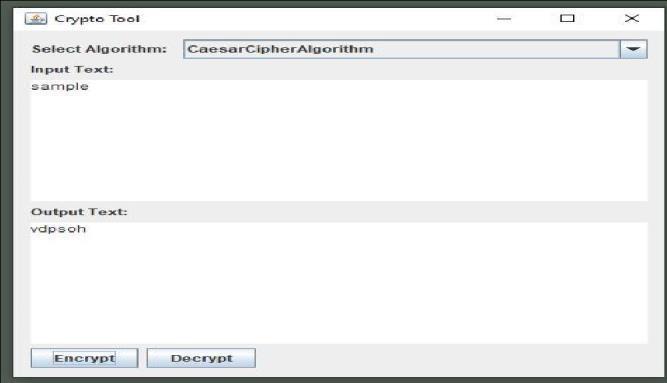
Figure: - 03(Caeser Cipher Encryption )
a. Giventheciphertextandtheknownshiftvalue(e.g.,3).
b. Iteratethrougheachcharacterintheciphertext.
c. Shift each letter in the ciphertext backward in the alphabetbythechosenshiftvalue.
d. Handle wraparound if the shift extends beyond the boundsofthealphabet.
e. Outputthedecryptedtext.
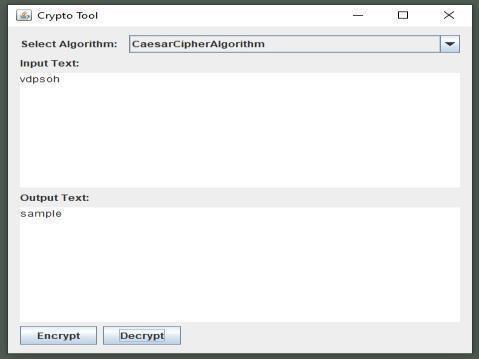
Figure :- 04(Caeser Cipher Decryption)
2) Modified Caeser Cipher
It’ssimplyatypeofsubstitutioncipher,i.e.,eachletterofa given text is replaced by a letter with a fixed number of positionsdownthealphabet.
For example withashiftof2,AwouldbereplacedbyC,B wouldbecomeD,andsoon.

International Research Journal of Engineering and Technology (IRJET) e-ISSN: 2395-0056 p-ISSN: 2395-0072
Volume: 11 Issue: 04 | Apr 2024 www.irjet.net
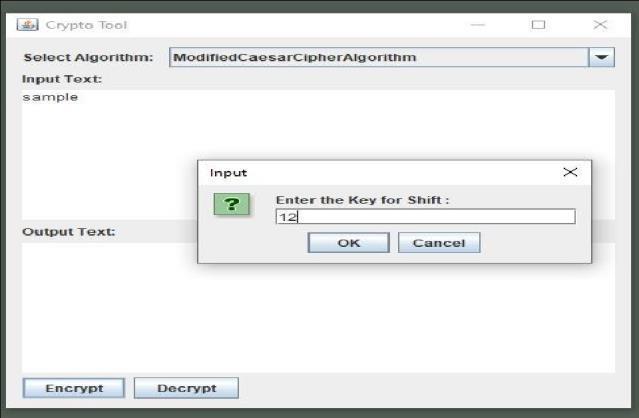
a) Iteratethrougheachcharacterintheplaintext.
b) Determine the shift value for the current character based on its position or any other criteriayou'vedefined.
c) Applytheshifttothecurrentcharacter.Besureto handle wraparound (if shifting past 'z', loop back to 'a'orviceversa).
d) Append the modified character to the encrypted text.
e) Repeat this process for all characters in the plaintext.
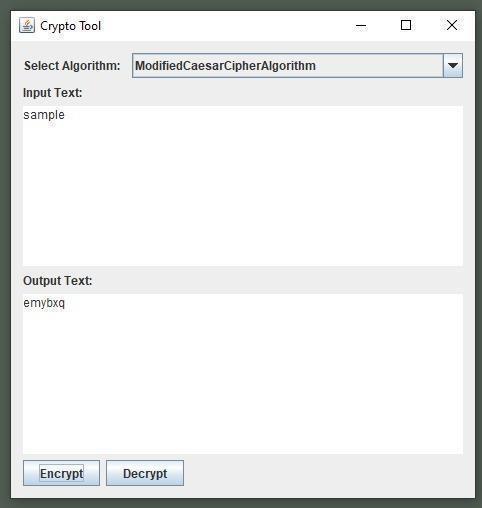
a. Performthereverseoftheencryptionalgorithm.Iterate througheachcharacterintheencryptedtext.
b. Determinetheshiftvaluefor thecurrentcharacterbased onitspositionoranyothercriteria.
c. Applytheinverseshift(shiftintheoppositedirection)to thecurrentcharacter.
d. Appendthemodifiedcharactertothedecryptedtext.
e. Repeat this process forall characters inthe encrypted text.
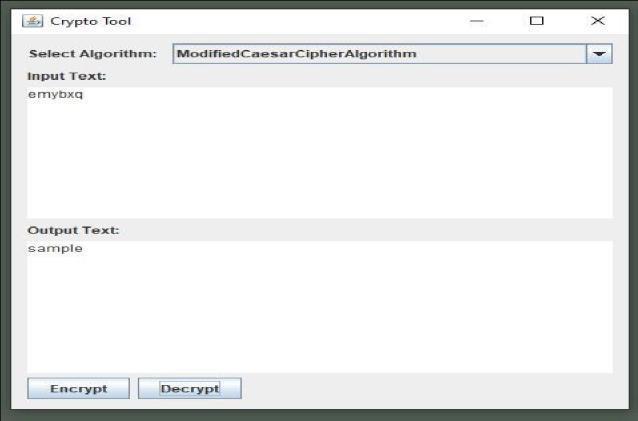
AES (Advanced Encryption Standard) is a symmetricencryptionalgorithmmajorlyusedfor securingsensitiveandconfidentialdata.Herethis algorithm is specifically making with the help of JAVACryptographicExtensionFramework.AES256, a variant of AES, employs a 256-bit key for encryptionanddecryption.Itoperatesonblocksof data, typically 128 bits, and applies a series of substitution, permutation, and mixing operations (SubBytes, ShiftRows, MixColumns, and AddRoundKey)inmultiplerounds(10roundsfor AES-128, 12rounds for AES-192,and 14roundsfor AES-256) to achieve strong cryptographic security. Forexample,AES-256encryptsa128-bitblockof plaintextusinga256-bitkey,producingciphertext that is computationally infeasible to decrypt withoutthekey.
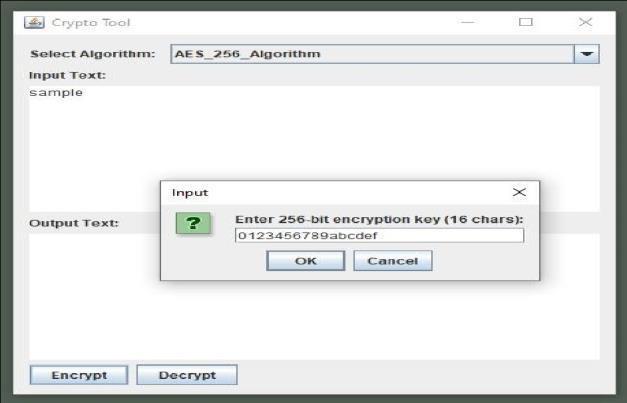

International Research Journal of Engineering and Technology (IRJET) e-ISSN: 2395-0056 p-ISSN: 2395-0072
Volume: 11 Issue: 04 | Apr 2024 www.irjet.net
Key Expansion:Generateroundkeysfromtheoriginal encryptionkey.
Initial Round: AddRoundKey step, where each byte of the state is combined with a block of the round key.
Rounds:ConsistingofSubBytes,ShiftRows,MixColumns, andAddRoundKeytransformations.
Final Round:OmitMixColumnsstep.
Outputthefinalstateastheciphertext.
Thesestepsiterativelytransformtheplaintextblockinto ciphertextusinga256-bitkey.
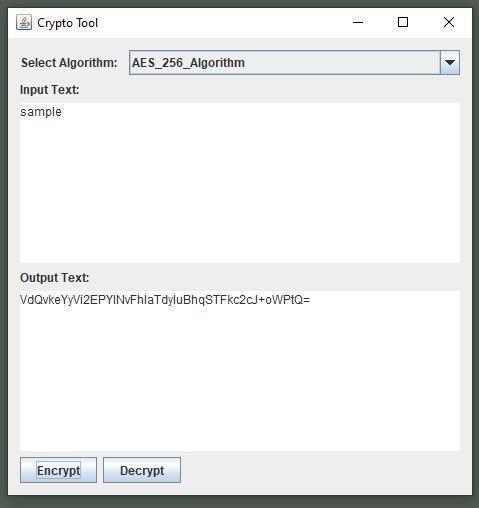
Figure: - 09 (AES-256 Encryption)
Decryption Logic
Key Expansion:Generateroundkeysfromtheoriginal encryptionkey.
Initial Round:InverseAddRoundKeystep.
Rounds: Inverse SubBytes, Inverse ShiftRows, Inverse MixColumns,andInverseAddRoundKeytransformations.
Final Round:OmitInverseMixColumnsstep. Outputthefinalstateasthedecryptedplaintext.
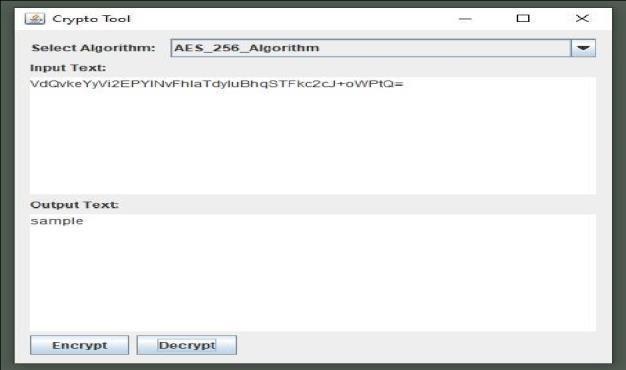
Figure: - 10 (AES-256 Decryption)
RSA (Rivest-Shamir-Adleman) is a widely-used asymmetricencryptionalgorithm.WeusedhereJAVA Cryptographic Extension Framework to stud and implementthisalgorithm.
1. KeyGeneration:Generateapublic-privatekey pair consisting of a public key (e, n) and a privatekey(d,n).
2. Choosetwolargeprimenumbers,AandB.
3. Computen=A*Bandφ(n)=(A-1)*(B-1).
4. Selecte,relativelyprimetoφ(n),asthepublic exponent.
5. Calculated as the modular multiplicative inverseofemoduloφ(n).
6. Encryption:Toencryptamessagem,compute ciphertextc=m^emodnusingtherecipient's publickey.
7. Decryption: To decrypt the ciphertext c, computethe plaintextm =c^dmodnusingthe recipient'sprivatekey.

International Research Journal of Engineering and Technology (IRJET) e-ISSN: 2395-0056 p-ISSN: 2395-0072
Volume: 11 Issue: 04 | Apr 2024 www.irjet.net
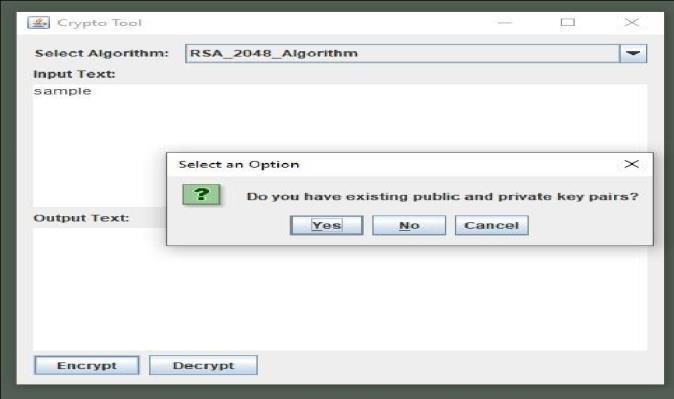
Figure: - 11(Asking for existing Public Key & Private Key)
Encryption Logic
Toencryptamessagem,computeciphertext c = m^e mod n usingtherecipient'spublickey(e,n).
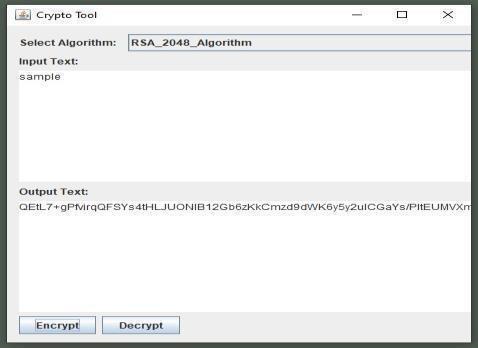
Figure: - 12(RSA Encryption)
Decryption Logic
Todecrypttheciphertextc,computetheplaintext m = c^d mod n usingtherecipient'sprivatekey.

Figure: -13 (RSA Decryption)
Thearithmeticalgorithmisbasedentirelyonthe integerarray,whichisaconvertedversionofabytearray. The byte array is derived from the ASCII values of the characters from the input file. For simplicity and understanding,let'sconsiderthecontentoftheinputfile as "ABCD". The tool reads this input file in the form of ASCIIvalues,resultinginthebytearray:{65,66,67,68}. Thisbytearraycanvaryinsizebasedontheinputfile;the toolcreatesanarrayofthatsize,witheachelementhaving abytedatatype.Wethenconvertthisbytearrayintoan integer array as follows: {65, 66, 67, 68}. In this integer array, each element has an int data type. This preprocessing step is necessary for the algorithm as it operatesonintegerarrays.
1. InitialRound:
Readthetextfromthefile.Convertittothebytearrayof Asciivalueofeachcharacterpresentoverintheinputfile 2. Rounds:
Convert the type of Array as we required whole byteArrayintoanintArrayforfurtherprocess
DifferencebetweenthetermsinArraysandstoreas samepositionstartingfromindex-0tilllengthof thearraywhereastheindex-0element remains constantforthisround.
•Intheresultantarrayweperformedsomearithmetic operations like addition and multiplication for little complexity
• Sum the terms in Resultant Arrays and store as same position starting from index-0 till length of the arraywhereastheindex-0elementremainsconstantfor thisround.
• In the resultant array we performed subtraction operationsforbitcomplexity.
3. FinalRound:
Concernaboutreadability weconvertbackthisASCII valuestocharacters.

International Research Journal of Engineering and Technology (IRJET) e-ISSN: 2395-0056 p-ISSN: 2395-0072
Volume: 11 Issue: 04 | Apr 2024 www.irjet.net
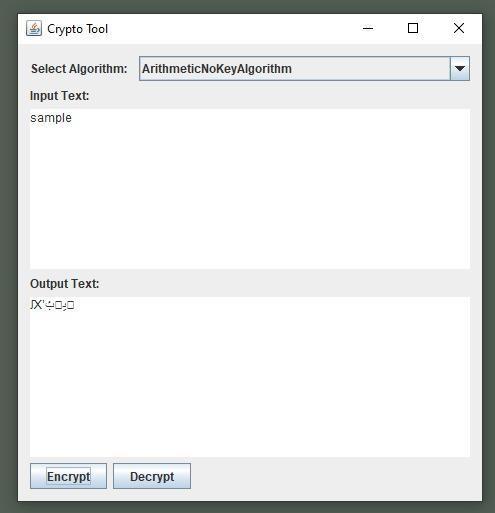
- 14(Arithmetic No Key Encryption)
Decryption Logic
1. InitialRound:
Read the text from the file. Convert it to the byte array ofAscii value of each character present overin theinputfile
2. Rounds:
Convert the type of Array as we required whole byteArrayintoanintArrayforfurtherprocess.
On intArray, we performed Addition operations for bitcomplexity.
Difference in the terms in Resultant Arrays and store as same position starting from intArray.length-1 till index0 of the array whereas the index-0 element remains constant for this round.
In the resultant array we performed some arithmetic operations like addition and multiplication forlittlecomplexity
Sum the terms in Resultant Arrays and store as samepositionstartingfromindex-0tilllengthofthe array whereas the index-0 element remains constantforthisround.
3. Final Round:
Concernaboutreadabilityweconvertbackthis ASCIIvaluestocharacters.
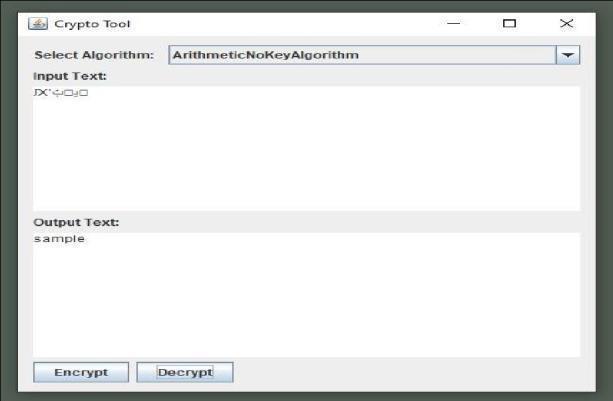
Advantages:
1. SimpleImplementation: Thealgorithmis relatively easy to understand and implement, making it accessiblefordevelopers.
2. NoKeyRequired:Asthenamesuggests,itoperates without a key, which simplifies the encryption process.
3. Readability: It ensures readability by converting ASCII values back to characters in the final round, whichcanbebeneficialdependingontheusecase.
4. Variable Input Size: It can handle input files of varyingsizes,adaptingthearraysizeaccordingly.
Disadvantages:
1. Limited Security:Sinceitoperates withouta key,it might not provide robust security against sophisticatedattacks.
2. Potential for Information Loss: Depending on the operations performed, there's a risk of losing informationduringencryptionanddecryption.
3. Simplicity Might Lead to Vulnerabilities: The simplicitythatmakesiteasytoimplementcouldalso makeitmorevulnerabletoattacksorexploitation.

Volume: 11 Issue: 04 | Apr 2024 www.irjet.net
Bitmanipulationalgorithms aretotallybased onthebitsofeachelementoftheintegerarray,which isaconvertedversionofabytearray.The bytearray is received from the ASCII values of the characters fromtheinputfile.Forsimplicityandunderstanding, suppose"ABCD"isthecontentoftheinputfile.Then the tool reads that input file in the form of ASCII values, resulting in the byte array as follows: Byte array={65,66,67,68}Now, thisbytearraycanhave a variable size, depending on what you give in the input file. Thetoolwill createan array ofthat size, and each element will have the data type byte. We thenconvertthatbytearrayintoanintegerarrayas follows: Int array = {65, 66, 67, 68} In this integer array, each element has the data type int. Now, all operationsaredoneonthebitlevelofeachelement in the integer array. So now, each operation is performedonthebitsasinputforfurtherprocessing.
Step:ConvertplaintexttoASCIIbytearray
Step2:Convertbytearraytointarray(Convert bytetounsignedint)
Step3:BitOperationwitheverysingle bit
Step4:XOReachelementwithconstant Step5:DisplayasASCIIcharacterstring.
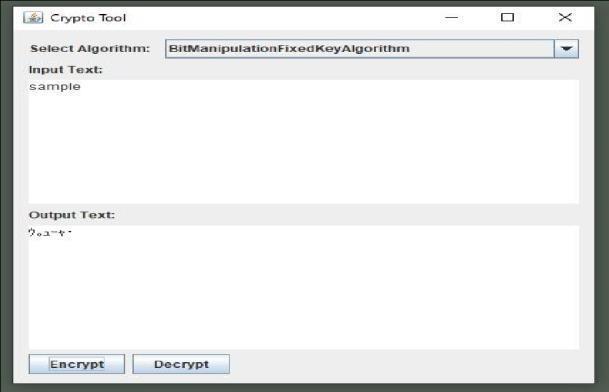
Decryption Logic
Step1:Convertencryptedtexttointarray
2395-0056 p-ISSN: 2395-0072
Step2:XOReachelementwithconstant
Step3:BitOperationwitheverysinglebit
Step4:DisplayasASCIIcharacterstring.
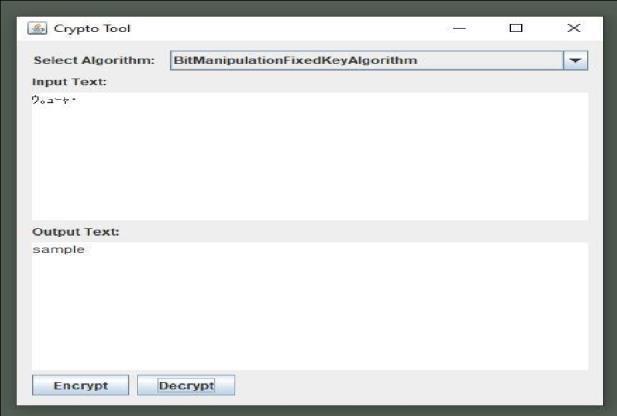
1. Bit-LevelOperations:Operatingonthebitlevelcan provide finer control over encryption and decryptionprocesses.
2. Fixed Key: Using a fixed key simplifies the encryptionanddecryptionprocesses,reducingthe overheadofmanagingandexchangingkeys.
3. Efficiency: Bit manipulation operations can be efficient in terms of computational resources comparedtoarithmeticoperations.
4. Potential for High Security: Depending on the complexityofthebitmanipulationoperationsand the strength of the fixed key, it can offer higher securitycomparedtosimpleralgorithms.
Disadvantages:
1. Complexity:Bitmanipulationoperationscanbe complextounderstandandimplement,requiringa deeperunderstandingofbitwiseoperations.
2. LimitedFlexibility:Usingafixedkeymeansthat thealgorithmmightlackflexibilityinadaptingto differentsecurityrequirementsorscenarios.
3. RiskofKeyExposure:Sincethekeyisfixed,ifit's compromised,alldataencryptedusingthatkey becomesvulnerable.
4. LossofReadability:Bit-leveloperationsmight resultinencrypteddatathat'slesshumanreadablecomparedtoASCII-basedencryption.

Volume: 11 Issue: 04 | Apr 2024 www.irjet.net
1. CeaserCipher 1.sample
2.Hello World@ 123 0.0173 5359480
3.Secure Data 0.0162 3832456
4.Hi therewe are testing an algorith m 0.5168 6863048
2. Modified CaeserCipher 1.Sample
3.
3. AES-256 Algorithm
3.Secure Data
4. RSA Algorithm 1.Sample 5 87512
ArithmeticNo key Encryption
Bit Manipulation Fixedkey encryption
The table gives a comparison of different encryption algorithms based on their performance metrics, including the time taken to encrypt, memory usage,andexampleciphertexts.
Caesar Cipher:
1) It'sabasicencryptionmethodthatshiftslettersbya fixedamount.
2) It'srelativelyfast,takingasmallfractionofasecond toencryptevenlongmessages.
3) Itusesamoderateamountofmemory.
4) Example:Encrypts"Sample"in0.1731milliseconds.

International Research Journal of Engineering and Technology (IRJET) e-ISSN: 2395-0056 p-ISSN: 2395-0072
Volume: 11 Issue: 04 | Apr 2024 www.irjet.net
Modified Caesar Cipher:
1) SimilartotheclassicCaesarCipherbutwithsome changes.
2) Encryptiontakes longercompared to the original CaesarCipher.
3) Usesamoderateamountofmemory.
4) Example: Encrypts "Hello World@123" in 678 milliseconds.
AES-256 Algorithm:
1) Amoreadvancedencryptionstandardknownforits strongsecurity.
2) Encryptionis slowercomparedtotheCaesarCipher variants.
3) Requiresahigheramountofmemory.
4) Example: Encrypts "Secure Data" in 115 milliseconds.
RSA Algorithm:
1) Apublic-keyencryptionmethod.
2) Encryption times are higher symmetrickeyalgorithms. compared to
3) Usesamoderateamountofmemory.
4) Example:Encrypts"Hitherewearetestingan algorithm"in113milliseconds.
Arithmetic No Key Encryption:
1) Anencryptionmethodwithoutusingaspecifickey.
2) It'sfastandusesrelativelylowmemory.
3) Example:Encrypts"Sample"in0.0779milliseconds.
Bit Manipulation Fixed Key Encryption:
1) Encryptsdatausingfixedbitmanipulation techniques.
2) Fastencryptionwithmoderatememoryusage.
3) Example: Encrypts "Hello World@123" in0.0231 milliseconds.
In summary, different encryption methods offer varying levels of security, speed, and memory usage. WhilesimplermethodsliketheCaesarCipherarefast and require less memory, more advanced algorithms likeAESand RSAprovidestrongersecurity butat the costofincreasedcomputationalresources.
Algorithm Optimization: Investigate methods to optimize the performance and efficiency of the implemented algorithms, such as enhancing encryption and decryption speed or reducing memory usage, to ensure scalability and applicabilityinlargescalesystems.
Security Analysis and Improvements: Conduct rigorous security analysis of the implemented algorithmstoidentifypotentialvulnerabilitiesand develop robust countermeasures. Additionally, explore the integration of post-quantum cryptography techniques to enhance resistance againstquantumcomputingthreats.
User Authentication and Access Control: Extend the platform to include features for user authentication and access control, such as multifactorauthenticationandrole-basedaccesscontrol, to enhance security and usability in real-world applications.
Integration with Cloud Services: Explore the integrationoftheplatformwithcloudservicesand distributed computing frameworks to facilitate securedatastorage,processing,andcommunication incloud-basedenvironments.
Inconclusion,thedevelopmentofacomprehensive platform for symmetric and asymmetric encryption algorithms represents a significant advancement in the fieldofcryptography.Byincorporatingmajorencryption modessuchasCaesarCipher,AES,ModifiedCaesarCipher, and RSA, alongside novel algorithms like Arithmetic No Key Algorithm and Bit Manipulation Algorithm, the platformprovidesuserswithaversatiletoolkitforsecure communicationanddataprotection.
Motivated by the need for a unified encryption solution,theprojectaimedtobridgeancientandmodern Encryption techniques while promoting awareness of cryptography's importance in today's technological era. Throughmodulardevelopmentandintegrationwiththe Java Cryptographic Extension Framework, the platform offersflexibility,usability,andeducationalvaluetousers rangingfromcryptographyenthusiaststoprofessionals.

International Research Journal of Engineering and Technology (IRJET) e-ISSN: 2395-0056 p-ISSN: 2395-0072
Volume: 11 Issue: 04 | Apr 2024 www.irjet.net
Looking ahead, there is ample opportunity for further research and development to enhance the platform's performance, security, and usability. Future endeavorscouldfocusonalgorithmoptimization,security analysis, user authentication, access control, and integrationwithcloudservices,ultimatelyadvancingthe platform'scapabilitiesandrelevanceindiversereal-world scenarios.Overall,thisresearchcontributestotheongoing evolutionandapplicationofcryptographyinsafeguarding digitalinformationandcommunications.
1. Menezes,A.J.,VanOorschot,P.C.,&Vanstone,S.A. (Year). Applied Cryptography: A Handbook. CRC Press Series on Discrete Mathematics and Its Applications.
2. 2.Vyas,B.(Year).SecurityIssuesandResolutions in Java Application Development. Journal Name, Volume(Issue),Pages.
3. ZhengyiLu."AnalysisonAESencryptionstandard andsafety",Proc.SPIE12462,ThirdInternational Symposium on Computer Engineering and Intelligent Communications (ISCEIC 2022), 1246215(2February2023).
4. Salami, Y., Khajehvand, V., & Zeinali, E. (Year). A Comprehensive Review of Cryptographic Algorithms: Analysis of Existing Literature, Vulnerabilities, and Ongoing Challenges. Department of Computer and Information Technology Engineering(IT), Qazvin Branch, IslamicAzadUniversity,Qazvin,Iran.Receivedon 07April2023;Acceptedon31May2023.
5. ArwaZabian,ShakirMrayyen,AbrammagdyJonan, TareqAl −shaikh,MohammedtthaziAl −khaiyat. “Multi-layer encryption algorithm for data integrity in cloud computing”, International Journal Artificial Intelligent and Informatics 63 Vol.3,No.2,December2022.
6. Al-Shabi,M.A.(Year).AnOverviewofSymmetric and Asymmetric Cryptography Algorithms in Information Security. International Journal of Scientific and Research Publications, Volume 9(Issue3),March[2019].
7. Prof.(Dr.)AmitVerma,AnjaliGakhar.“Analysisof Tools and Techniques in cryptography”, FPInternationalJournalofComputerScience
Research(IJCSR)Volume2,Issue1,Pages37-44, March2015.
8. Punita Meelu & Sitender Malik. “AES: A SYMMETRIC KEY CRYPTOGRAPHIC SYSTEM”, International Journal of Information Technology andKnowledgeManagementJanuary-June2011.
9. Tanusree Saha. "Complement-Based Modified ApproachtoSecureSmallTextMessageCombining Triangulation Method”, International Journal of innovation in Engineering and Technology (IJIET),Volume6,Issue4April2016.
10. Deepak & Parveen “Modern Encryption and Decryption Algorithm based on ASCII Value and Binary Operations” International Journal of ComputerApplications(0975–8887)Volume172 –No.1,August2017.
11. Shashi Gautam, Shubha Mishra,& Dr. Manish Shrivastava’s“AnEnhancedEncryptionTechnique usingBCDandBitComplementation”International ResearchJournalofEngineeringandTechnology (IRJET),Volume:04Issue:01|Jan-2017.